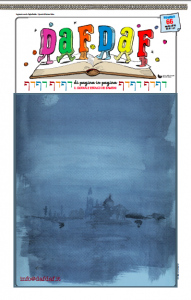MEDIA Venice Super-Star on DafDaf
Venice is the main star of issue 66 of DafDaf, the Jewish magazine for kids, in time for the first initiatives organized for the fifth centenary of the Jewish Ghetto, the area that has become a universal symbol of exclusion.
“Campo del Ghetto, in Venice, is surrounded by canals, and it resembles a small island. It is a square, in fact, and like all those of the city on the Lagoon it is called Campo. But it is an unusually large Campo, and it is not uncommon to find someone who will take the opportunity to play some football!”
Some info about the museum, the particularities of the various “scole”, the synagogues, some info about the language and the images from “The Ghetto of Venice, 500 Years of Life,” the film directed by Emanuela Giordano form a beginner’s guide to Venice. The illustrations chosen for DafDaf come from “a small guide that is really worth taking along when visiting Venice with kids”: part of the homonymous Edizioni EL series, the “Guidina” (small guide) of Venice is written by Sarah Rossi and illustrated by Stefano Turconi and besides giving precise information on the best routes to discover the city it narrates much of its history, its people and its traditions.
The cover of DafDaf, by Luisa Valenti, is devoted to Venice too, as it is the page called “Strega comanda color”, that Luisa has transformed this month in a sort of graphic guide to the city. Roberta Anau is the author of the pages on food and tradition, and in DafDaf 66 the upcoming occurrence of Purim is the excuse to learn two sweet recipes, the “Buricchi dolci” and the “Festoni”.
The pages by Morà Dafdafà, Nedelia Tedeschi, are about Purim as well, and the author has used the dialogue with the children and musical instruments to underline one of the main values of a day too often known only for costumes and laughter: “you can learn from Purim that in front of a bully, a violent, a cruel being we must not remain silent and be submissive, but we must raise our voices and react so that good will prevails over evil “.
The pages about the reality of Israel, called simply “Eretz” begin with a small mystery: “Once you open that creaky envelope, the fragrance of peanut butter (not peanut, really peanut butter, so popular among American boys) will occupy the space, and when you have tasted these strange non-chips shaped like a sort cylindrical cloud, then you will not be able to stop”. The snack is Bamba, of course, by far the most common snack in Israel: the company that produces it “every day prepares a million packages to be distributed in shops and supermarkets in the country, an impressive figure if you think of a population of roughly eight million”. Maybe not the healthiest food in the world, but in DafDaf we have published an excuse that children cold use to convince adults to get some: an American scholar, Gideon Lack, found that Bamba could have helped the Israelis to avoid allergy to peanuts. “Several years ago – he explained – we found that the risk of peanut allergy development was 10 times higher among Jewish children in the UK compared to Israeli children with similar ancestry, an observation linked to a striking difference in the time when peanuts are introduced in the diet in these two countries. Babies in UK typically do not consume peanut-based foods in the first year of life, while in Israel, they are usually introduced into the diet when children are about seven months old. This finding led to the hypothesis that the early introduction of peanuts in the diet can provide protection from allergy development”.
“History and Stories” is dedicated to Israel, too, since it tells the story of David Ben Gurion: “He was born in Plonsk – a Polish town then under Russian rule – on 16th October 1886, to a Jewish family. Not only he himself declared ‘To be a realist you must believe in miracles’ (the title of the page), but he was one of the founding fathers of Israel, as well as the first Prime Minister of the country. ”

